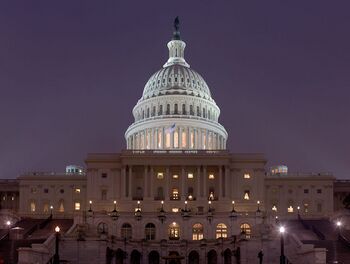U.S. Congress: Difference between revisions
imported>Shamira Gelbman m (→Institutional structure and powers: articles -> sections) |
imported>Shamira Gelbman (revised for accuracy - the constitution doesn't specify 100 and 435) |
||
| Line 1: | Line 1: | ||
{{subpages}} | {{subpages}} | ||
{{Image|US Capitol Building at night Jan 2006.jpg|right|350px|The U.S. Capitol, [[Washington, D.C.]].}} | {{Image|US Capitol Building at night Jan 2006.jpg|right|350px|The U.S. Capitol, [[Washington, D.C.]].}} | ||
The '''United States Congress''' is the national legislature of the [[United States of America]]. As established in Article I of the [[U.S. Constitution]], it is a [[bicameral legislature|bicameral]] institution that includes a | The '''United States Congress''' is the national legislature of the [[United States of America]]. As established in Article I of the [[U.S. Constitution]], it is a [[bicameral legislature|bicameral]] institution that includes a [[U.S. Senate|Senate]] consisting of two members for each state and a [[U.S. House of Representatives|House of Representatives]] with seats allocated to each state based on its population. | ||
==Precursors== | ==Precursors== | ||
Revision as of 14:43, 5 August 2009
The United States Congress is the national legislature of the United States of America. As established in Article I of the U.S. Constitution, it is a bicameral institution that includes a Senate consisting of two members for each state and a House of Representatives with seats allocated to each state based on its population.
Precursors
In September 1774 the colonies, without British authorization, sent delegates to Philadelphia to respond to harsh laws the British imposed on Massachusetts. It issued "The Declaration of Rights and Grievances" and called for a systematic boycott of British goods to add economic punch to their philosophical arguments for more home rule.
The First Continental Congress set up the Second Continental Congress which gathered in May 1775. War had broken out and the Congress took control of the army, waged war, and negotiated treaties. It declared independence on July 4, 1776, creating a new nation, the "United States of America." The Third Continental Congress (1776-1781) drafted the Articles of Confederation in 1777; they were ratified in 1781.
The Confederation Congress created by the Articles followed the same rules. Each state sent a delegation, which had one vote. Decisions required 9 votes (out of 13), and amendments had to be unanimous. Unable to levy taxes, it asked the states for money, printed paper money, and borrowed heavily. In the 1780s it convinced the states to give it their western lands, then started selling the lands to settlers. Its most notable legislation was the Northwest Ordinance of 1787, which created the Northwest Territory of the United States.
Institutional structure and powers
The U.S. Congress was created by Article I of the United States Constitution, which contains ten sections devoted to the Congress's institutional design and the scope of its powers.
The Congress has two houses ("bicameral"), compared to the one-house ("unicameral") Continental Congress. Members vote as individuals rather than as states, except in rare cases involving presidential elections. The new House of Representatives gave states seats in proportion to their population (counting all the whites of all ages, and 3/5 of the slaves.) Each state has two senators.
The U.S. Congress has significant power, tempered by the checks and balances provided by the executive and judiciary branches.
